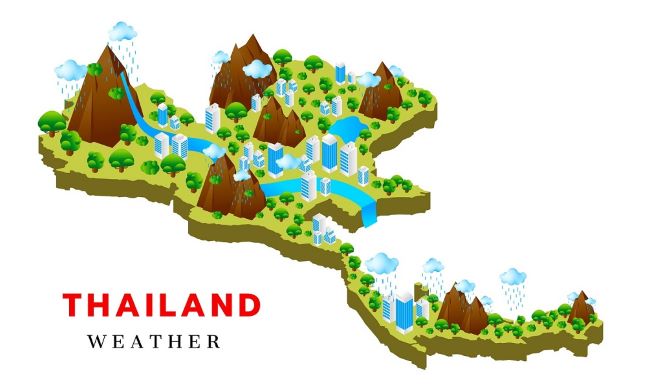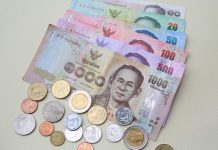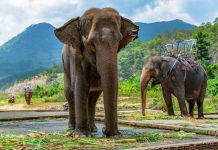
Thailand locates in the tropical zone close to the equator resulted the weather of this country is tropical wet and dry climate or the tropical savanna climate (Aw) according to the Köppen climate classification. And the south and the easternmost is tropical monsoon climate. The average temperature is between 19-38 degree Celsius. The hottest period is mid of April and after then with the influence of the southwest and the northwest monsoon produce the effect to the rainy season and wintertime respectively. The rain cover over all the country except in some areas. The period of the rainy season and the rainfall are varied depending on the locations and the altitude.
Monsoon
Thailand is under the influence of the southwest and the northeast monsoon.
The Southwest Monsoon
The southwest monsoon blows over Thailand between the mid of May to the middle of October. It typically occurs in the high-pressure area in the southern hemisphere in the India Ocean. It flows from the centre to be the southeast monsoon and transfer to be the southwest when it crosses over the equator. The storm will bring about the air mass from the India Ocean to Thailand resulted in it is cloudy and rainy specifically along the coastal areas and wind face mountain ranges which are much more rainfall than other areas of the country.
The Northeast Monsoon
After the influence of the southwest monsoon, then in the mid of October estimate, the northeast monsoon blows over Thailand until the middle of February. This wind typically occurs in the high-pressure area in the northern hemisphere in Mongolia and China, and it flows the cold and dry air mass to cover Thailand. The consequence, the sky is clear and the weather during this period is cold and dry in overall especially in the north and northeast of the country. While it is wet in the south, in particular, the south-east coast of Thailand since this monsoon brings the humidity from the Gulf of Thailand to this region.
Seasons of Thailand
Thailand has 3 seasons; summer, rainy, and winter.
1. Summer

The summer in Thailand starts in the middle of February through the mid of May which is the time that the northeast monsoon is transferring to the southwest monsoon and also it is the time that the north pole faces to the sun. In particular, in April the sun is nearly right above the head at noon resulted Thailand thoroughly exposes the heat from the sun. The climate in this period generally is swelter.
Nonetheless, it is sultry and drought across the country in the summer, sometimes the cold air mass from China spreads over to the upper land of Thailand and causes the confrontation of the cold air mass and the warm air mass that cover above the country. As a result, it is the thunderstorm and hailstorm which may cause any damage. The thunderstorm occurs in this period also called “Summer storm”. The weather in summer according to the highest temperature daily are by following;
- Hot weather: the temperature is between 35-39.9 degrees Celsius.
- The hottest weather: the temperature is between 40 degrees Celsius upwards.
The recommended tourist spots: Beaches and Islands in the south and east.
2. Rainy Season

The rainy season started in the Mid of May when the southwest monsoon blows over Thailand together with the trough caused it is wet across the country. This trough typically flows over the south of Thailand in May and in turn upraises to the north. In late June approximate, it flows over the south of China resulted it is lesser rainfall for a while. And it takes time about 1-2 weeks or maybe over months in some year. In July, regularly the through descends back to Thailand resulted it is raining continuously until the northeast monsoon blows over the country instead of the southwest monsoon in the mid of October.
For this reason, the upper of Thailand starts to be colder and less of rainfall specifically in the north and northeast regions. While it is lots of rain in the south until December, however sometimes the rain is too heavy and cause to the flood especially in the south-east coast which is more rainfall than the west coast. Notwithstanding, the rainy season can start 1-2 weeks sooner or later than the definable period. The measurement of the rain within 24 hours daily starts from 7.00am to 7.00am on the next day by following;
- Uncountable rainfall: less than 0.1 millilitres.
- Lightly rainfall: It is between 0.1-10.0 millilitre.
- Medium rainfall: It is between 10.1-35.0 millilitre.
- Heavy rainfall: It is between 35.1-90.0 millilitre.
- Very Heavy rainfall: It is 90.1 milliliter upwards.
The recommended tourist spots: Mountains and peaks that feature different beauty from the winter. Furthermore, there are the waterfalls, stepped rice farming including to the indoor sightseeing such as museums, art galleries and exhibitions, playhouse, etc.
3. Winter Season

The winter season in Thailand starts in the mid of October to the middle of February when the northeast monsoon flows over Thailand since the middle of October which takes approximately 1-2 weeks. It is the time that rainy season turns to be the winter when it is the period that vulnerable climate whether cold and thunderstorm partially the lower central and the east of Thailand that enter to the winter later than the north and northeast. The weather in winter measure from the lowest temperature of each day by following;
- The Coldest weather: The temperature is between 8.0-15.9 degrees Celsius.
- Cold weather: The temperature is between 16.0-22.9 degrees Celsius.
- Cool weather: The temperature is between 16.0-22.9 degrees Celsius.
The recommended tourist spots: It is famous for the tourists to visit the high mountains and peaks which are plentiful of blooming flowers, for example, Mae Fah Luang Garden in Doi Tung Villa, Chiang Rai, the Royal Park Rajapruek, Doi Anf Khang, and Doi Inthanon in Chiang Mai.
Temperature in Thailand
Since Thailand is in the tropical zone, thence it generally results in the weather swelter all year round with the average temperature at 27 degrees Celsius estimate. Nonetheless, the temperature is varied on the region and season. The climate of the central, upper east and the north of Thailand are very different between the summer and winter, also the daytime and night time. In the summer, the highest temperature can exceed 40 degrees Celsius or more in March to May, particularly in April which is the hottest month of the year.
While the winter, the lowest temperature in the early morning drops to be cold to the coldest temperature especially in December to January when it is the coldest time of the year. At that time, the temperature can drop to the freezing point in the north and the northeast of the country at the of mountain ranges or high peaks. While the area nearby the coast – the lower east and the southern regions, the weather is less vulnerable. The weather in these areas is not extremely hot in the summer or cold in the winter.
The Rainfall
Commonly, Thailand has the proper rate of rainfall. Most parts of the country have approximately 1,200-1,600 milliliters of rain per annum and the number in total all through the year is about 1,587.7 milliliters. The rainfall is variedly followed to the geography besides the season variation. Regularly, it is drought and few showers of rain in the winter in the upper of Thailand and it is a little more rain when it enters to the summer with some thunderstorm specifically in the area in front of the mountain range or the side that face the southwest monsoon. The areas are in the west and the east partially at Klong Yai district in Trad with its rainfall all year round in total is 4,000 milliliters.
On the other hand, in the area behind the mountain is less of rains which are the land in the lower north, the central, and the west of the northeast of Thailand. While it is wet almost the year in the south except in the summer that the southwest coast which is the area that the southwestern monsoon blows over is more rainfall than the east coast. The most rainfall period of the year is in September.
In the winter time, the south-east coast which faces to the northeast monsoon is more rainfall than the west coast and the most rainfall period is in November. Ranong is the most rainfall province in the south with its total rainfall is approximately 4,000 milliliters while the fewest rainfall in this region is the upper south-east coast in the area backward of Tanao Si or Tenasserim Range – Petchaburi and Prachuabkirikhan provinces.
Relative Humidity
Thailand is close to the equator; therefore, the weather is tropical wet almost the year except to the landwards area from the central upwards that the relative humidity tends to be lower obviously in the winter and the summer. In particular in the summer which is the period with lowest relative humidity of the year. The areas have the average relative humidity of about 73-75% all year round and tend to be lower to 64-69% in the summer.
The lowest relative humidity is only 9% that recorded on February 25, 1983, at Leoi and on April 23, 1990, at Chiang Rai. The coastal area in the east and the south are higher relative humidity especially in the south with its average relative humidity all through the year at 79-80%.
The Weather VS. Tourist Attractions in Thailand
Since the weather is one of the most important factors to choose where is the right place to visit. And there are lots of locations in Thailand that offer the opportunity for the tourists to visit throughout the year, nonetheless somewhere is suitable to travel in specific time. For example, if you would like to take a trip to the sea and experience the clear water and have fun with the water activities.
Then, the summer is the right time to visit the sea site since it is the best time with the sunny and bright sky. Or if you would like to travel to the mountain, so the winter season is the best time because of the cold climate with the sea of fog and the blooming flowers. Otherwise for one who loves the freshness and drenched then you should visit the mountain site during the rainy season when you can touch the light vapour covers the mountain range and the fresh, lush trees that allows you to enjoy the lovely scenery of nature.
Since Thailand is in the tropical wet zone with the average temperature between 30-35 degrees Celsius that is quite very warm for the tourists especially Chinese, Korean, Japanese, or even local. On the other hand, the foreign visitors from Europe, America, or middle east instead love this weather. (European would say that it is warmer than their country and one from the middle east would say it is cooler than their homeland).
In case you take the trip in the rainy season, the temperature will drop and experience some sprinkle rain. So, please check the weather forecast before travel and bring along the umbrella and raincoat.
- Any day which pleasant climate is sunny, bright sky without or have some cloudy. It recommends to visit any outdoor sightseeing as much as you can since it is the best opportunity for you to take lots of nice pictures.
- If you face the rain, then you should try to make an indoor program. The places like museums, shopping malls, playhouses, etc are great for you to wander around.
- Bring along a bottle of water with you while you are taking tour in Thailand especially on the hot sunny day.
However, there are many tourist attractions in Thailand that welcome the tourists all through the year such as the Buddhist temples and other religious holy sites. And also, the floating markets and flea markets that do not only offer you a lot of interesting products and souvenirs but you can enjoy seeing the way of life of the rural dwellers that is different from the urbanists. Moreover, the important traditions and cultures of each location that is so exciting to experience, as well.
With the diversity of tourist attractions in Thailand, so it assures any seasons the tourist would enjoy and have a pleasant moment to travel to Thailand.









